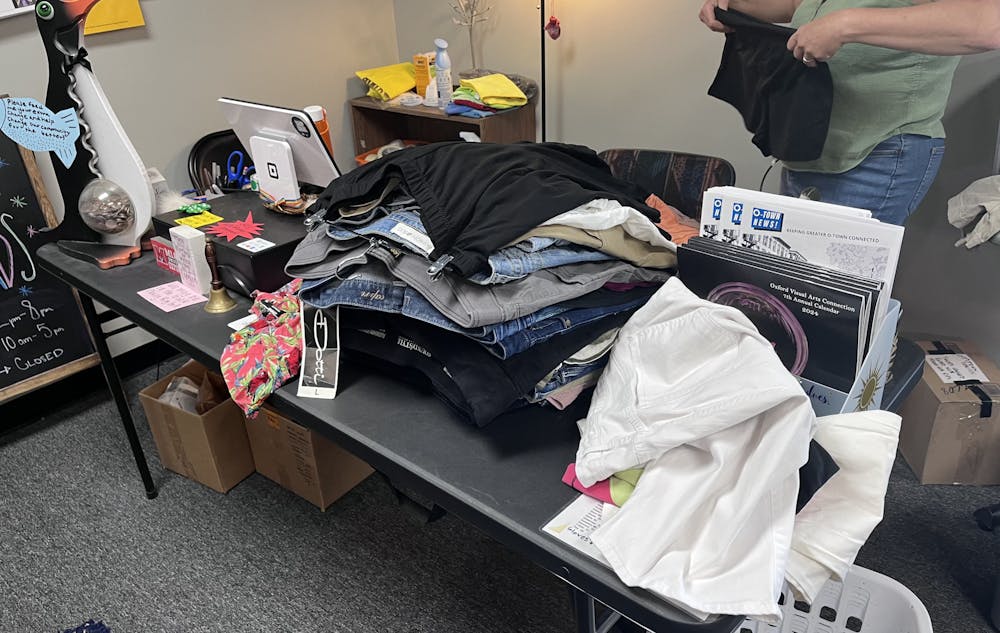After months of freezing temperatures, sunny days are finally back in Oxford. Campus lawns are dotted with students stretched out on picnic blankets to bask in the newfound heat. But as we ditch our winter coats for t-shirts, how much thought are we putting into our shopping choices?
In a few weeks, online fast fashion retailers such as Shein and FashionNova will begin promoting summer sales boasting massive discounts. These deals are compelling, and the ease of buying online compared to in-person shopping is particularly attractive to busy students.
Jaylyn Noureddin, a first-year public health major, said she shops mindfully but has found that the convenience and variety of shopping online is sometimes useful.
“I think the main issue is that when I shop in person, there’s not as many options,” she said.
Fast fashion retailers often offer more variety than in-person retailers, but at an ethical and environmental price. Sarah Dumyahn is an assistant teaching professor in the Institute for Environment and Sustainability who acknowledges the appeal and social pressures that come with fast fashion.
“In terms of the accessibility of being able to purchase clothes online, it makes it much easier,” Dumyahn said. “...The haul videos, the turnover for fashion trends, that’s all putting a lot of pressure on consumers to think that they should be getting these things.”
Dumyahn refers to the recent trend of influencers showing off large amounts of items they’ve purchased from unsustainable sources. These hauls are often promotional material from fashion retailers and drive viewers to make poor consumer choices.
“All of this is causing a greater amount of consumption,” Dumyahn said. “All of this resource extraction, and then all of it goes to landfills.”
66% of textiles in the U.S. end up in landfills each year, and overseas production and shipping alone account for 2.5% of global carbon dioxide emissions. The fast fashion industry is ultimately responsible for 10% of global C02 emissions, and that’s only one way the industry is environmentally harmful.
The labor conditions of the fast fashion industry are also highly concerning. Dumyahn cites the 2013 Bangladesh Rana Plaza collapse as an example of the horrible labor conditions overseas fast fashion workers are subjected to.
“We had a result of loss of life stemming from a building that wasn’t structurally sound,” Dumyahn said. “That’s also part of this model of creating clothing inexpensively and at a high volume. My concern is the environmental and social element of this.”
It may seem hard to align sustainability with comfort and style, but there are a variety of conscious ways to shop sustainability this summer.
Enjoy what you're reading?
Signup for our newsletter
Thrifting and buying secondhand
Donating clothes you no longer need and actively choosing second-hand clothing is a great place to start when shopping sustainably. When you buy second hand, you extend the lifetime of a piece of clothing and keep it out of a landfill.
High-quality textiles such as cotton, linen or lyocell can unfortunately be higher cost for consumers. However, looking for items made from these fabrics at thrift stores is a better choice for both the planet and your pocket.
Oxford is home to multiple second hand stores where you can start your thrift shopping journey, such as Goodwill and ThreadUp Oxford.
Updating what you own
Sometimes, you may need to check if what you want is already in your closet! If you have something similar to an item you plan to buy, try altering or upcycling it to fit a new purpose. This is an opportunity to put a unique twist on what you already own while learning new skills and reducing waste.
Guides to upcycling are widely available online or in magazines like Pebble Magazine.
Using third-party sustainability platforms
If you’re unsure about whether a brand or shop is sustainable or not, some apps and websites aggregate sustainability information to empower consumers.
Greenhive is a website that allows users to look up the name of a brand and view an associated environmental and ethical rating. The site collects data on a brand’s transparency, labor practices, use of materials and a wide array of other factors to gauge its overall sustainability.
It’s important to not become overwhelmed by the environmental impact of your actions. It’s great to be a conscious consumer, but always keep in mind that no individual action is responsible for climate change.
Curating your summer style should be a fun, yet conscious experience!




